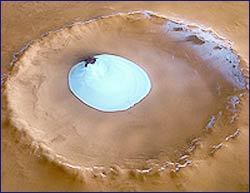This area deals with the fundamental laws and building blocks of nature and how they interact, the properties and the behavior of matter, and research into space and time and their structures.
innovations-report provides in-depth reports and articles on subjects such as astrophysics, laser technologies, nuclear, quantum, particle and solid-state physics, nanotechnologies, planetary research and findings (Mars, Venus) and developments related to the Hubble Telescope.

The latest close flyby of Saturn’s icy moon Enceladus by NASA’s Cassini spacecraft confirms that the moon has a significant, extended and dynamic atmosphere. The flyby, which took place on 14th July 2005, was Cassini’s lowest altitude flyby of any object to date, a mere 173 kilometres (108 miles) above the surface of Enceladus.
The 500 km diameter moon Enceladus is a very bright icy moon at a distance of 4 Saturn radii away from Saturn. It has long been associated with the formation of

The situation regarding titanium is paradoxical. On the one hand, titanium is found in abundance in the natural environment: in terms of natural occurrence in the earth’s crust, the element is the third among all metals, directly following iron and aluminium. In industry, particularly in metallurgy it is used very rarely, about one hundred times less than aluminium. This happens in spite of the outstanding properties of titanium: it is lightweight, fast, heatproof and chemically stable. But it

Physicists at the University of Pennsylvania have overcome a major hurdle in the race to create nanotube-based electronics. In an article in the August issue of the journal Nature Materials, available online now, the researchers describe their method of using nanotubes tiny tubes entirely composed of carbon atoms — to create a functional electronic circuit. Their method creates circuits by dipping semiconductor chips into liquid suspensions of carbon nanotubes, rather than growing the nanotu

Using high-speed collisions between gold atoms, scientists think they have re-created one of the most mysterious forms of matter in the universe — quark-gluon plasma. This form of matter was present during the first microsecond of the Big Bang and may still exist at the cores of dense, distant stars.
UC Davis physics professor Daniel Cebra is one of 543 collaborators on the research. His main role was building the electronic listening devices that collect information about the

A team of researchers from the California Institute of Technology in Pasadena, CA, Yale University in New Haven, CT, and Gemini Observatory in Hilo, HI, report the discovery of a new planet in the outer solar system. Officially designated 2003 UB313, the new planet is intrinsically brighter than Pluto and three times farther away. Assuming the reflectivity of the surface is the same as Pluto’s, it is the largest object detected in the solar system since the discovery of Neptune and its moon

This image, taken by the High Resolution Stereo Camera (HRSC) on board ESA’s Mars Express spacecraft, show a patch of water ice sitting on the floor of an unnamed crater near the Martian north pole.
The HRSC obtained these images during orbit 1343 with a ground resolution of approximately 15 metres per pixel. The unnamed impact crater is located on Vastitas Borealis, a broad plain that covers much of Mars’s far northern latitudes, at approximately 70.5° North and 103° East.